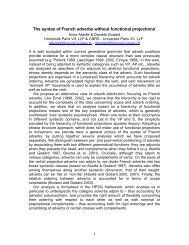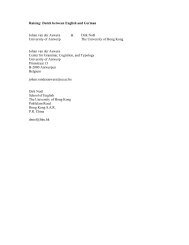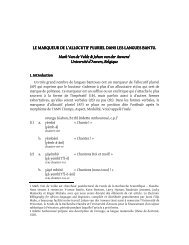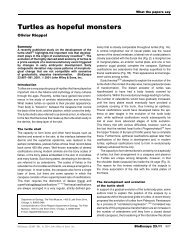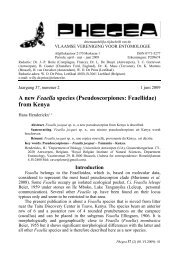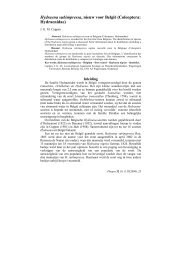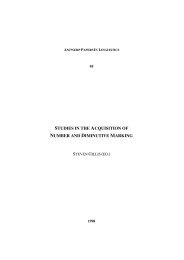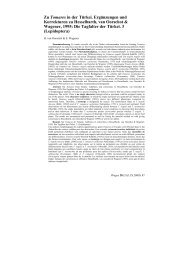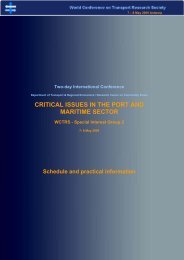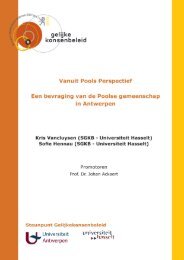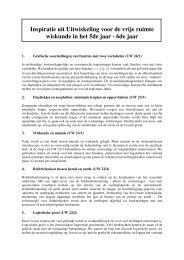Theodor2005.pdf
Theodor2005.pdf
Theodor2005.pdf
You also want an ePaper? Increase the reach of your titles
YUMPU automatically turns print PDFs into web optimized ePapers that Google loves.
168 Theodor and Foss<br />
Table I. Continued<br />
75. stapedial artery sulcus on promontorium present (0); absent (1) (Cifelli, 1982; Thewissen and<br />
Domning, 1992)<br />
76. foramen for superior ramus of stapedial artery present (0); absent (1) (Thewissen 2001, modified from<br />
Novacek, 1986)<br />
77. suture between pars cochlearis of petrosal and basisphenoid/basioccipital present (0); absent (1)<br />
(Thewissen and Domning, 1992)<br />
78. ectotympanic ring-shaped (0); bulla-shaped (1) (Geisler and Luo, 1998)<br />
79. ectotympanic thin-walled (0); thick involucrum (1); filled with cancellous bone (2) (modified from<br />
Thewissen et al., 1994)<br />
80. posterior extension of bulla, stylohyoid does not rest in notch on caudal edge of bulla (0); present,<br />
bulla expanded around stylohyoid, forming notch on caudal edge of bulla (1); bulla extends caudal to<br />
stylohyoid medially (2); bulla extends caudal to stylohyoid laterally (3); dorsal end of stylohyoid<br />
enveloped or nearly so by bulla (4) (Geisler, 2001a,b; modified from Gentry and Hooker,<br />
1988)<br />
81. furrow on caudal tympanic for tympanohyal absent (0); present (1) (Thewissen et al., 2001; modified<br />
from Geisler and Luo, 1998)<br />
82. sigmoid process (homologous to anterior crus of tympanic ring) absent (0); present (1) (Thewissen,<br />
1994)<br />
83. ectotympanic does not form part of tubular external auditory meatus (0); contributes (1) (Thewissen<br />
et al., 2001; modified from Geisler and Luo, 1998)<br />
84. hypoglossal foramen close to occipital condyle (0); closer to jugular foramen (1) (Thewissen et al.,<br />
1994)<br />
85. condyloid foramen absent (0); present, separate from hypoglossal foramen (1) (Geisler and Luo, 1998)<br />
86. stylomastoid foramen incomplete (ectotympanic contacts tympanohyoid laterally and pettrosal<br />
medially, in some cases ectotympanic separated from petrosal by narrow fissure) (0); complete<br />
(ectotympanic contacts both tympanohyoid and petrosal) (Geisler, 2001a,b)<br />
87. subarcuate fossa present (0); absent (1) (Novacek, 1986)<br />
88. mastoid exposed on posterior side of braincase between squamosal and occipital (0); no posterior<br />
exposure of mastoid ( = amastoid) (1) (Thewissen et al., 2001)<br />
89. mastoid foramen present (piercing mastoid) (0); absent (1) (MacPhee, 1994; Thewissen et al., 2001)<br />
90. subarcuate fossa of petrosal contains no deep depression (0); contains deep depression that opens<br />
rostrally and is enclosed medially by bony arch of semicircular canal (1) (see Norris, 1999, 2000)<br />
91. posttemporal canal on petrosquamous suture in caudal view (0); absent (1) (Wible, 1990; MacPhee,<br />
1994; Thewissen et al., 2001)<br />
92. basioccipital crests (= falcate processes) absent (0); present (1) (Geisler, 2001a)<br />
93. occipital condyles broadly rounded in lateral view (0); V-shaped in lateral view or divided transversely<br />
in caudal view (1) (Geisler, 2001a,b)<br />
Axial Skeleton<br />
94. odontoid process of axis forms cranially directed peg (0); spout-like trough dorsal surface (1); bears<br />
medial dorsal ridge/ditch(?) separating two “spout-like” troughs (2) (modified from Webb and Taylor,<br />
1980; Geisler, 2001a)<br />
95. atlantoid facet of axis restricted below neural arch or extends slightly dorsal to base of neural pedicle<br />
(0); extended dorsally at least half way up neural arch (1) (Geisler, 2001a,b; modified from Webb and<br />
Taylor, 1980)<br />
96. cervical vertebrae short, length less than centra of cranial thoracics (0); long, length of centrum greater<br />
than or equal to the centra of the cranial thoracics (1); very long, length close to twice the length of the<br />
cranial thoracic centra (2) (Geisler, 2001a,b; from Gingerich et al., 1995)<br />
97. arterial canal for vertebral artery in cervical vertebrae 1–6: caudal openings exterior to neural canal<br />
(0); inside neural canal (1) (Gentry and Hooker, 1988)<br />
98. revolute zygapophyses of lumbar vertebrae absent (0); present (1) (Thewissen et al., 2001)<br />
99. number of sacral vertebrae less than four (0); four (1); more than four (2) (Thewissen and Domning,<br />
1992; Gingerich et al., 1995)<br />
100. clavicle present (0); absent (1)<br />
101. sacroiliac articulation broad between pelvis and S1 (possibly S2) (0); narrow articulation with end of<br />
transverse process of S1 (1); S1 articulation absent (2) (Geisler and Luo, 1998)<br />
Forelimb<br />
102. scapula, acromion overhangs glenoid (0); does not overhang glenoid (1) (Thewissen et al., 2001;<br />
modified from O’Leary and Rose, 1995)<br />
103. prespinous fossa and postspinous fossa of scapula equal in size (0); postspinous fossa larger than<br />
prespinous fossa (1)



